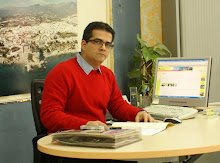Andalusia, south of Spain
Is divided for administrative purposes into eight provinces, three of them inland: Jaen, Cordoba and Seville, and five of them on the coast: Almeria, Granada, Malaga, Cadiz and Huelva. Three of them, Granada, Cordoba and Seville, have been declared Heritages of Mankind.
It is a region situated between Europe and Africa, and bathed by the waters of two seas, the Mediterranean and the Atlantic.
With strong Islamic roots, Andalusia is perhaps the least European part of Western Europe. But the region's heritage is Spanish as well as Moorish.
The Islamic palaces, picturesque little villages, ragged mountains and endless coastline makes it an exotic and attractive location.
The rich nature in Andalusia offers the travellers fascinating contrasts of snowcapped mountains and superb beaches, mountains and lush green plains, modern cities and enchanting towns. Its little villages are enveloped in a historical and cultural ambience where visitors will encounter the true spirit of the region.
Climate
In Andalusia we enjoy over 300 days of sun a year and more than 800 kilometres (about 500 miles) of Mediterranean and Atlantic coastline divided by the Costa del Sol, Costa de la Luz and Costa Tropical.
The summers are hot and dry and the winter period offers a mild climate with some rain. The best period to travel in Andalusia is in March til the middle of June and from the middle of september to November (included). During the hot summer months of July and August temperatures can reach more than 40°C/104°F - a time for beach holidays. There are cold periods in the Winter especially in the mountainous regions. The peaks of the Sierra Nevada in Granada are snow-covered all over the year.
Brief history
The existence of human populations in the region goes back to the early Palaeolithic era and from those dates are many archaeological sites, such as cave paintings. In the beginning of the historic era, Andalusia maintained the population of Tartesus, the first organized state on the Peninsula.
Later, The Greeks and the Phoenicians established their costal colonies and cities creating great trading centre such as Cadiz. After a century as a Carthaginan province, Rome conquered Andalusia.
In 711, we find the key date of Andalusian history. The occupation of the first Arab contingents was the beginning of eight centuries of Islamic domination. The Caliphate of Cordoba was a flourishing period making the entire region the cultural centre of Western Islam.
The disintegration of the Caliphate constituted a grand opportunity for the Northern Christian kings. After Castile and Leon's unification by Ferdinand III, there was a great movement for the establishment of a Christian Andalusia. The Catholic Kingdom ended the splendid past of Al-Andalus with the fall of Granada in 1492, the same year Andalusia contributed to the decisive discovery and the later conquest and colonizing of America.
Culture - Places to visit
Some of the things which we most associate with Spain are typically Andalusian - flamenco dancing, bullfighting, white villages and gazpacho. Andalucia is the birthplace of famous artists like Velazquez, Picasso, Federico García Lorca and many others.
The beach is not the only attraction of Andalucia. Wherever you are within this region you have the opportunity of getting to know the most genuine aspects of its culture by making short trips by car or in organised bus excursions.
Here are a few examples of the most popular places to visit:
Cordoba - Capital of Muslim Spain in the 10th century
- The Mosque (Mezquita which dates back to the 10th century)
- The Seville Gate in Cordoba (Fortified tower from the primitive entry gate to the Alcazar or fortress)
- The Alcazar and its walled gardens (Massive walls and towers which date from Moorish times and the Christian kings, recently reconditioned in order to house the Diocesan Museum)
- The Diocesan Museum of Fine Arts in Cordoba (This recently created museum is located at the old Episcopal palace)
Seville - Today's capital of Andalusia
- Cathedral of the City of Seville (One of the largest richly decorated Gothic cathedrals in Western Europe)
- The Alcazar of Seville (Fortress of the Moorish and later of the Christian kings)
- The Plaza de España and the large Parque of María Luisa (The Ibero-American Exhibition was held in this park with its surrounding moat and semicircular complex with fountains, monumental staircases and extensive tile work)
Granada - A declared national monument
-The Alhambra Palace (Outstanding Islamic palace, residence of the Moorish rulers)
-Palacio de Generalife (To the east of the Alhambra, this was the summer palace of the Moorish kings)
-Cathedral of Santa María de la Concepción (A memorial to the victory of Christian Spain, it is the country’s finest Renaissance church)Malaga city - Chief centre of the Costa del Sol
- Alameda Principal (Malaga’s main artery)
-The Alcazaba (A stronghold of the Moorish kings)
- Archaeological museum of Malaga (Located within the Alcazaba, with finds of Roman material and of Hispano-Arab pottery)
- Roman Theatre (On the west side of the Alcazaba are the remains of this Roman theatre discovered in the 1951)
- Gibralfaro (Fortifications dating from the 13th century)
Cadiz - Probably the most oldest town of the Iberian peninsula
- Seafront promenades (Promenades on the Atlantic coast)
- Church of Santa Catalina (Contains Murillo’s last painting)
- Plaza de España
- Church of Sagrario or the old Cathedral
To find accommodation in Andalucia, south of Spain, please click on the following active links:
Vacation Rentals in Costa del Sol, south of Spain


